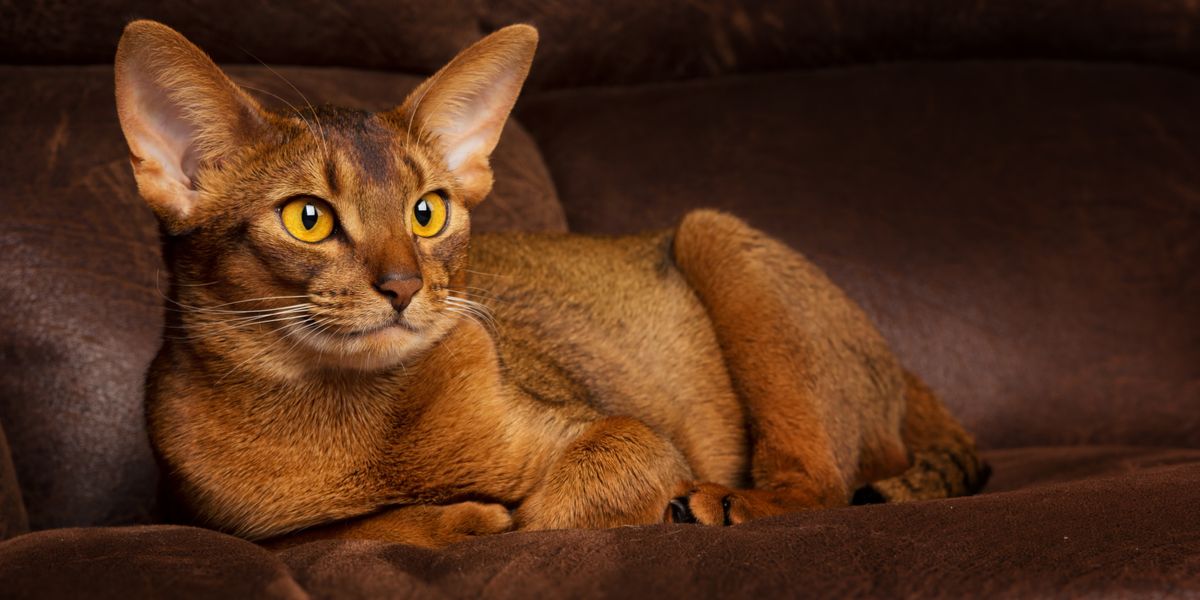
Brown cats are not particularly rare. Brown, especially brown tabby (brown with black stripes) is a very common color in cats. Solid brown cats are somewhat less common, and can be strikingly beautiful. In some breeds, the solid brown color is called chocolate. Some pointed breeds also come in brown colors, such as the seal point Siamese.
In cats, brown coats come in a range of hues, from very light tan to deep chocolate brown. Brown cats also come in a variety of different patterns, including solid brown, brown tabby, brown spotted tabby, brown ticked, brown spotted, brown pointed (often called chocolate point), and bi-colored (brown with white).
One purebred cat breed comes only in brown—the Havana Brown, which is solidly colored in a rich and even shade of warm brown. Many other popular cat breeds come in brown, but also come in other colors, whether solid, patterned, or pointed. Some breeds do not come in brown at all, including the Bombay, Burmilla, Chartreux, Korat, Nebelung, and Russian Blue.
Many of the pedigreed cat breeds recognized by the Cat Fanciers Association and The International Cat Association come in brown. Let’s meet some popular brown cat breeds.
#1 American Wirehair

Image Credit: https://cats.lovetoknow.com/cat-breeds/american-wirehair-cat-breed-personality-profile
The American Wirehair can trace its roots back to one kitten born on an upstate New York farm in 1966. This kitten had a unique wiry coat due to a spontaneous genetic mutation. The American Wirehair’s medium-length coat is unlike that of any other cat breed. It is springy, dense, and resilient, but also coarse and hard to the touch.
All individual hairs are crimped, hooked, or bent, including the whiskers and the hair inside the cat’s ears. The American Wirehair comes in many different colors and patterns, including brown tabby. The breed is quiet, gentle, and affectionate.
#2 Bengal
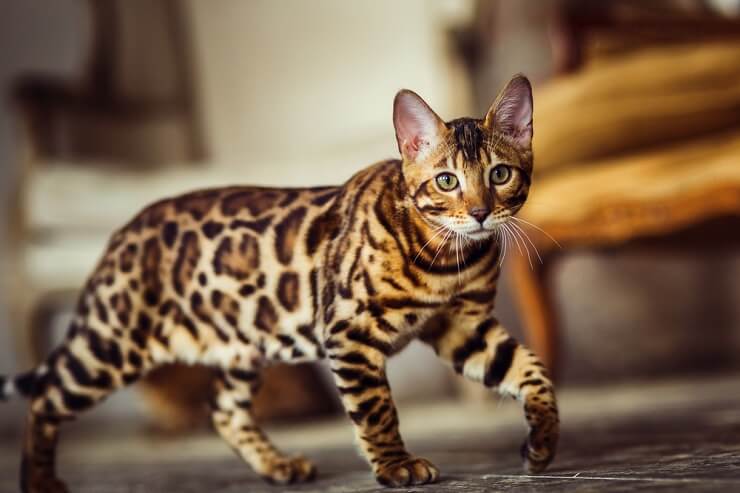
The Bengal breed was created in the 1980s by crossing domestic cats with the Asian Leopard Cat, which is a small wild cat species native to Asia. The goal of the breeding program was to produce domestic cats that looked wild but had loving, dependable temperaments. The program was a success. The Bengal is the only breed that has spotted markings called rosettes, which resemble the markings found on wild cats like leopards, jaguars, and ocelots. Rosettes preferably have two distinct colors or shades, such as paw-print shaped, arrowhead shaped, doughnut- or half-doughnut shaped, or clustered. Bengals come in several colors including brown.
Regardless of color the coat is always spotted or marbled, and may have glitter (a special type of hair that reflects light and makes it look as though the cat has been dusted with glitter). Bengals may look wild, but they are very affectionate and let you know what they are thinking with a lot of meowing. Highly active and curious, they need a lot of engagement and stimulation from their owners and don’t do well if left alone for long periods.
#3 Burmese
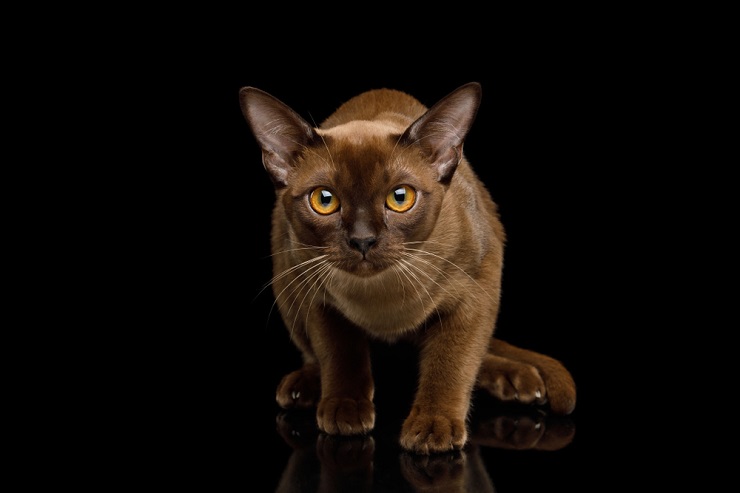
The Burmese cat comes in four colors, two of which are in the brown family. Sable is a rich, warm, sable brown. Champagne is a warm honey beige. (The other two Burmese colors are grey hues: blue, which is a medium gray, and platinum, which is a pale, light grey.) The four Burmese colors were inherited from the Siamese cat, which was used during the creation of the Burmese breed.
The Burmese’s coat, requires very little grooming, is very short and sleek, with a fine, glossy, satiny texture. The Burmese is extremely people-oriented and loving.
#4 European Burmese

Breed Overview
- ORIGIN: Burma and Thailand
- HEIGHT: 8″-10″
- ADULT WEIGHT: 8-10 pounds
- LIFE SPAN: 10-15 years
Closely related to the Burmese, the European Burmese is the version that was developed in United Kingdom, while the Burmese was developed in the United States. Both breeds trace their origins back to one cat that was used in early Burmese breeding programs in the 1930s. Though the two breeds have slightly distinct looks and separate breed standards, they are more similar than different.
Unlike the Burmese, which only comes in four colors, the European Burmese comes in several solid colors and parti-colors, including brown (a rich, warm, seal brown) and chocolate (a warm milk chocolate). European Burmese are playful, cuddly, and easy going.
#5 Havana Brown
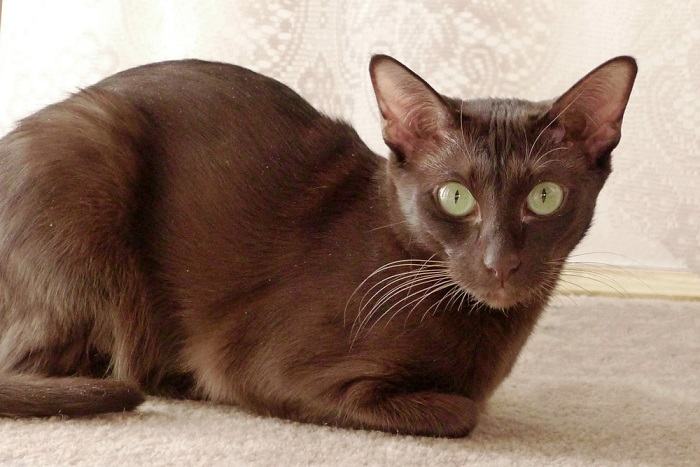
As its name implies, the Havana Brown cat only comes in solid brown. The hue is described as a rich, even shade of warm brown, with the color tending toward red-brown (mahogany) rather than black-brown. The Havana Brown is completely brown all over (self-brown), which means even the nose, paw pads, and whiskers are brown. It has vivid green eyes—a striking combination against the cat’s warm brown coloration.
Smooth and lustrous, the Havana Brown’s coat is short to medium in length. Despite its name, the Havana Brown did not originate in Cuba—it was developed in England in the 1950s. No one is exactly sure how the name came about, but it may have been named after the Havana rabbit (which comes in a similar brown color) or the rich brown color of a Havana cigar. This medium-sized breed is charming, affectionate, and just a touch mischievous.
#6 Maine Coon

The Maine Coon is known for being one of the largest of all cat breeds, with males weighing 20 pounds or more. The Maine Coon’s long, shaggy coat comes in almost every color and pattern imaginable except for chocolate, lavender, and the Himalayan (pointed) pattern. Acceptable brown shades include brown with tabby markings, brown patched tabby, and these two patterns with white.
Maine Coons developed naturally in Maine where it lived comfortably in the cold environment and excelled as a ratter. The breed was eventually designated as the official state cat of Maine. The breed, often called the “Gentle Giant,” is friendly, laid-back, and excellent with children.
#7 Manx

Image Credit: https://www.askideas.com/brindle-manx-cat-photo/
The Manx is one of only a handful of tailless cat breeds. The breed developed naturally on the Isle of Man, which is an island in the Irish Sea that lies between Ireland and Great Britain. No one knows for sure exactly how old the breed is, but the Manx was registered as one of the founding breeds when the Cat Fanciers Association was created in 1906. Though many Manx have no tails, some have partial tails and some have full tails.
A Manx with no tail is called a rumpy. A Manx with only a slight rise of bone where the tail should begin is called a rumpy riser. Only rumpies and rumpy risers are eligible to compete in championship classes at CFA cat shows. The Manx’s double coat, which may be long or short, comes in many colors and patterns, including brown tabby. The Manx is intelligent, active, loving, and loyal.
#8 Munchkin

The Munchkin is a dwarf breed, which means it has shortened legs. It was the first short-legged cat breed, resulting from a spontaneous genetic mutation in a kitten born to a stray cat in Louisiana in 1983. This dwarf kitten, named Blackberry, went on to birth more kittens with short legs, and the Munchkin breed was developed.
Named for the Munchkins that appear in the 1939 book The Wizard of Oz, the breed was accepted by The International Cat Association and awarded full championship status in 2003. The breed may have short hair or long hair, and may be any color, including brown. A healthy breed not more affected by arthritis or mobility issues than any other breed, the Munchkin is playful, curious, and outgoing.
#9 Oriental Shorthair

The Oriental Shorthair was developed in England in the 1950s when cat breeders experimented with crossing many different breeds with Siamese cats, including Abyssinians, British Shorthairs, Russian Blues, and even mixed breed cats. Kittens born in these crossbred litters were then bred back to Siamese, creating a new breed that looked very much like the Siamese with large ears and an elongated body shape, but in many more colors, patterns and coat lengths.
Today’s Oriental comes in many colors, including chestnut (a rich, chestnut brown) and cinnamon (a light, reddish brown). The coat may be short (fine textured and glossy or satin-like) or long (medium length, fine, and silky, without a downy undercoat). Oriental Shorthairs are active, inquisitive, and extremely people-oriented.
#10 RagaMuffin
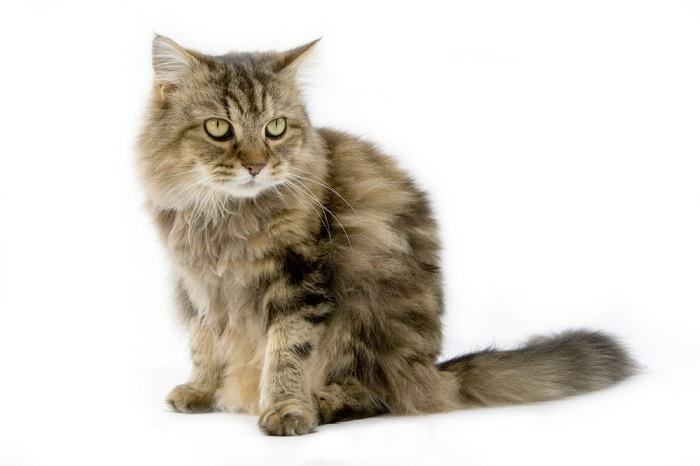
The RagaMuffin is a relatively young breed that was created in California in the mid-1990s. Though the breed’s exact origins remain mysterious, it was developed using an unrecognized breed called the “Cherubim,” which itself was created in the 1960s by breeding street cats. The RagaMuffin became standardized fairly quickly and gained CFA registration status in 2003, with full championship status awarded in 2011.
The RagaMuffin’ s soft, dense, silky coat is medium-long, but doesn’t require excessive upkeep as it resists matting. The coat comes in any color, including brown. Calm, patient, and extraordinarily sweet, RagaMuffins are known for getting along great with children and other pets.
Frequently Asked Questions
What breed of cat is brown?
Brown cats are not a breed of cat; brown is just a description of the cat’s coat color. Brown is a common color in domestic shorthair and domestic longhaired cats. One cat breed, the Havana Brown, only comes only in brown. Many other cat breeds come in brown, and also other colors. Some of these include the American Shorthair cat, American Wirehair cat, Bengal, British Shorthair cat, Burmese, the Devon Rex, Egyptian Mau, European Burmese, Exotic Shorthair, Maine Coon, Manx, Munchkin, Oriental Shorthair, Persian cat, Ragamuffin, and Sphynx.
Are brown cats rare?
Brown cats are not very rare. The color brown, especially the brown tabby pattern, is a very common color in cats. Solid-colored brown cats are less common than brown tabbies, and strikingly beautiful.
Do dark brown cats exist?
Several cat breeds come in dark brown, including the Burmese, European Burmese, Havana Brown, Oriental Shorthair, and Ragamuffin.
What do you call a brown cat?
In cats, the color brown is sometimes called chocolate. A striped brown cat is called a brown tabby cat.



